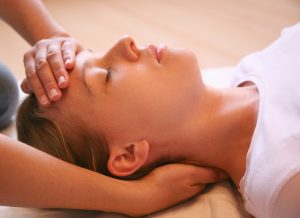If you’ve ever had a great massage, you understand how you can feel both relaxed and invigorated at the same time. This seeming dichotomy of emotions allows you this feeling of well being because a massage loosens muscles, increases oxygen and blood flow throughout the body, and encourages the free flow of the body’s own energies, or “Chi.”
The Japanese healing art of Reiki has similar practical purposes—to increase and free the unbalanced energy flow in the body. But while massage is more vigorous and manipulates the muscles, Reiki uses only touch and sometimes merely the proximity of the healer’s hands to particular parts of the body, using 12 to 20 prescribed hand positions, depending on the training tradition. Today there is a hybrid treatment, known as Reiki massage.
While massage is one of the oldest forms of medical treatment, first recorded in China more than 2,000 years ago, Reiki is a recently developed practice, invented in 1922 by Dr. Mikao Usui, a Japanese Buddhist. He gave treatments and passed his training on to a generation of about 16 Reiki Masters, who continued to practice and teach it to others as Usui Reiki.
Difference Between Reiki and Massage Therapy Training
To become a licensed massage therapist, you must attend an accredited massage school and take extensive coursework, which usually includes anatomy, physiology and other courses, in addition to massage techniques. Depending on the program, these programs can take from six months to two years. In many states, you must also pass a massage certification exam in order to be a licensed practitioner.
Reiki, on the other hand, is not licensed by any state board, but a few organizations have begun to establish criterion for this new healing art. The Reiki Licensing Commission for Reiki Masters and Healers (RLCRMH) for instance, has called for stricter standards of Reiki training, and awards designations for Reiki healers, coaches, masters and instructors. The lowest levels take about one or two days of training, and the highest level can take years to achieve.
There are other types of Reiki certification as well, such as Lightarian Reiki®, Urevia®, Shamballa Multi-Dimensional Reiki healing and Karuna. Usui Reiki healing techniques requires learning from a teacher who is directly in the Reiki lineage from masters taught by Dr. Usui or his student, Hawaiian Reiki master Hawayo Takata.
Reiki and Massage Therapy as Complementary Professions
In massage therapy, the practitioner manipulates the patient, whereas in Reiki, the healer barely touches the patient, in a non-invasive and non-manipulative 45- to 90-minute session. The practices are complementary, however, and many massage therapy schools also teach Reiki healing techniques so they can be incorporated into graduates’ private practices. Some massage therapists use Reiki techniques during their massage sessions, which is referred to as a Reiki massage, to promote physical, emotional and mental well-being.
